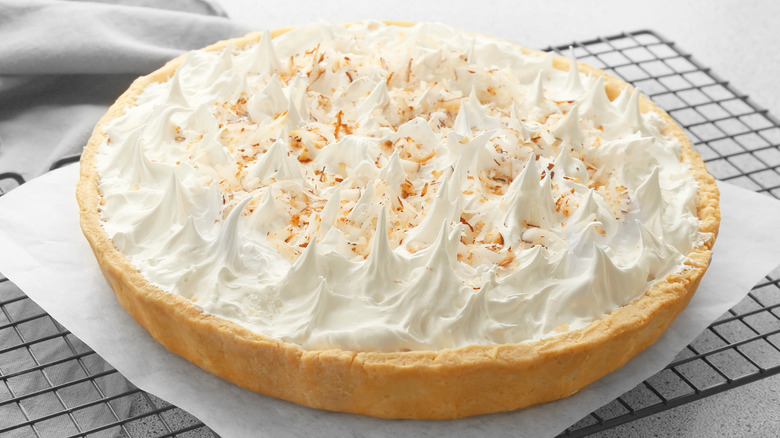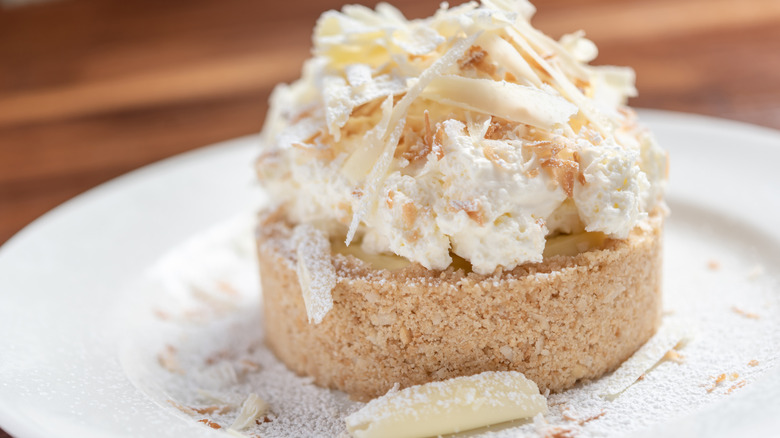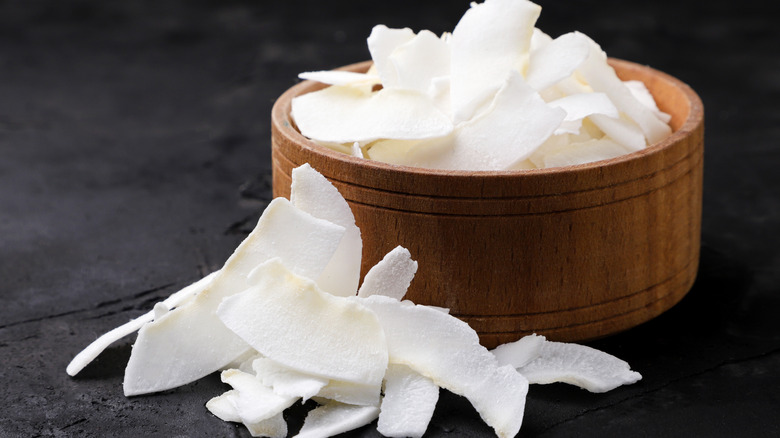The Murky Origins Of Coconut Cream Pie
There are a lot of desserts that seem so classic one could be forgiven for thinking they'd always existed: black forest cake, Boston cream pie, bundt cake. Coconut cream pie fits neatly into this category. Maybe you don't have it all the time, or even frequently, but it has to have been around forever, right?
Well, not really. Coconut cream pie started gaining broad appeal in the early 20th century, but its creation is a little trickier to pin down. It could have been as early as 1843, but even that's a bit iffy. What we have here is another food whose history is difficult to trace, much like the origins of chicken a la king and the true origin of hot dog buns. What we do know is that whenever it was invented, it didn't attain mainstream American success until someone figured out how to make coconut easy to transport and cook for Western nations.
The first coconut cream desserts emerged in the early 1800s
Until relatively recently in human history, you couldn't easily get tropical fruits unless you were close to the tropics. But in the 1800s, there were significant advances related both to the transportation and refrigeration of perishable goods. It made food that had previously been all but impossible to move in cost-effective amounts more accessible globally. This led to a craze in Europe and America over bananas and pineapples, but initially, coconuts got left behind. They were harder for Westerners to figure out what to do with and hard to preserve on their long journeys.
Still, there's evidence from the early 1800s that some people did try to cook desserts with coconut, even if they weren't yet onto coconut cream pie specifically. An 1824 cookbook called "The Virginia Housewife" features a recipe for "cocoa-nut cream," and a similar 1828 tract called "Seventy-Five Receipts for Pastry, Cakes, and Sweetmeats" features a couple of recipes for "cocoa-nut pudding." And there's an 1843 book titled "Mrs. Ellis's Housekeeping Made Easy" that actually does involve a recipe for "cocoanut pie" that bears some resemblance to the modern coconut cream pie — although the inclusion of wine (and the lack of a meringue topping) makes it clear this recipe isn't exactly a blueprint.
Dried coconut made coconut cream pie possible
These recipes were outliers, though, and it's easy to see why: You just couldn't get coconut in easily consumable form in America or Europe. But this changed in the early 1890s when a French export company in Ceylon (now Sri Lanka) figured out how to shred and dry coconut, creating the modern coconut flakes we are familiar with today. Suddenly, coconut could be easily transported far and wide — not to mention cooked without having to shell the fruit — so it was probably only a matter of time before it took off. It did exactly that after an 1895 incident where a miller in Philadelphia took delivery of a load of Cuban coconuts as restitution for a debt owed by a client. Sensing an opportunity, the intrepid businessman figured out how to dry the coconut flesh and started selling the results.
This iteration of coconut soon became popular in America. Although we don't quite know where the recipe for the original coconut cream pie came from during this period, by the turn of the 20th century, different variations on the same theme showed up in cookbooks all over the place. And while coconut cream pie's popularity may have waned during the latter half of the 20th century, it's still a classic, so we owe thanks to whoever it was who came up with the idea in the first place.


